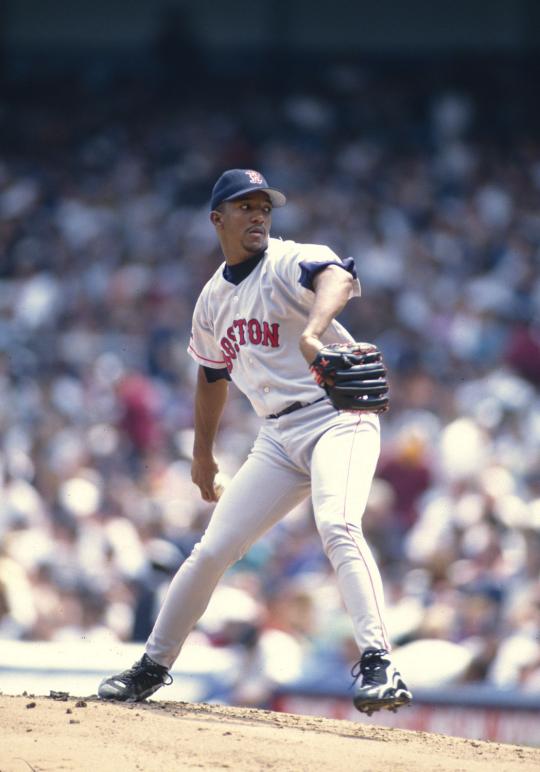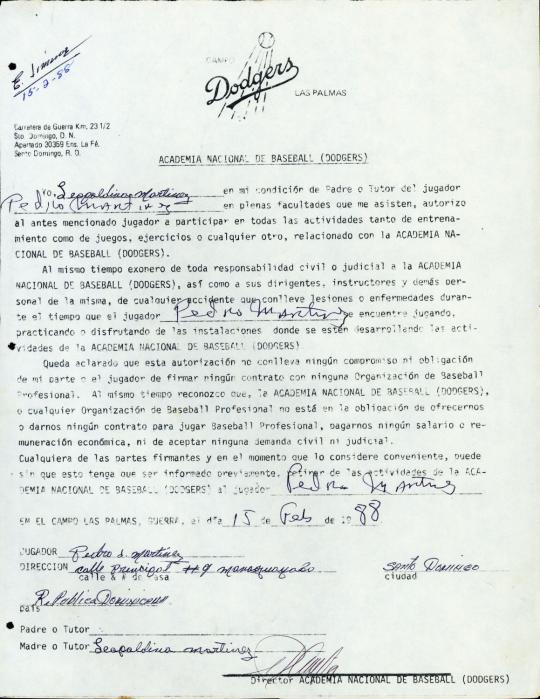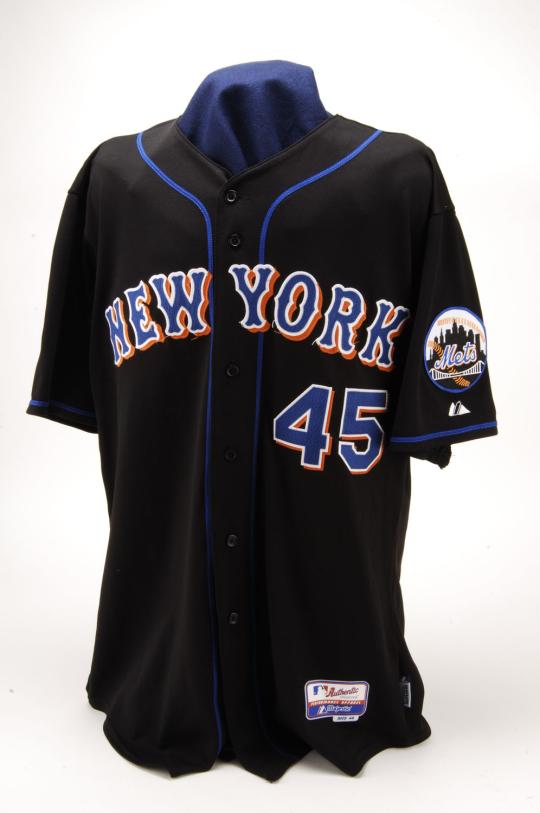- Home
- Our Stories
- Pedro Martinez debuts on BBWAA Hall of Fame ballot
Pedro Martinez debuts on BBWAA Hall of Fame ballot
At every stop in his baseball journey, Pedro Martinez was told he lacked the size to be a dominant starting pitcher.
And at every stop, the modest-looking right-hander – with huge hands and a heart to match – dominated opposing hitters like few ever have.
Now, Martinez stands at the precipice of the game’s most super-sized honor: The Hall of Fame.
Martinez debuts on the Baseball Writers’ Association of America Hall of Fame ballot this fall, one of 34 players on the 2015 BBWAA ballot for the Class of 2015.
BBWAA members who have at least 10 years of tenure with the organization can vote in the election, and the results will be announced Jan. 6. Any candidate who receives at least 75 percent of all BBWAA votes cast will be enshrined in the Hall of Fame as part of the Class of 2015. The Induction Ceremony will be held July 26 in Cooperstown.
Bio
Martinez, born in Manoguayabo, Dominican Republic, on Oct. 25, 1971, grew up with five brothers and sisters in a one-room home on the outskirts of Santo Domingo. His talent – and that of his brother, Ramon Martinez – soon attracted pro scouts.
“Talent is God-given,” Martinez said. “I have my own style. And there have been many, many teachers.”
Ramon signed with the Dodgers on Sept. 1, 1984. Pedro followed Ramon to Los Angeles, signing with the Dodgers on June 18, 1988. By 1990, Ramon was a 20-game winner in the big leagues – and Pedro was one of the Dodgers’ top prospects, despite his 5-foot-10 frame that carried less than 150 pounds in those days.
“I know who I am and where I came from,” Martinez said in 2011. “And I will never forget.”
In 1993, Pedro got regular work in the Dodgers’ bullpen, posting a 10-5 record in 65 games while striking out 119 batters in 107 innings. But following the season, the Dodgers traded Martinez to the Expos for second baseman Delino Deshields. After harnessing his explosive fastball over the next two seasons – which included a June 3, 1995 game where he retired the first 27 Padres batters he faced before allowing a hit in the bottom of the 10th – Martinez was named to his first All-Star Game in 1996 and then exploded onto the national scene the following year. In 1997, Martinez went 17-8 with a National League-best 1.90 earned-run average and 13 complete games, striking out 305 batters en route to his first Cy Young Award.
His combination of a 97-mph fastball, devastating change-up and pinpoint control made Martinez nearly unhittable.
“Every fastball hurts, hurts badly,” Martinez told the New York Post in 2005. “Imagine throwing a ball at 90 miles an hour, over and over again. People don’t know that every time you pitch a ball, you break blood vessels. Which is why we get our arms iced – so that the circulation can continue.”
But the Expos, knowing Martinez could become a free agent after the 1998 season, traded their ace to the Red Sox just days after he won the Cy Young. The Sox immediately locked up Martinez for the next seven seasons, setting in motion a virtually unprecedented string of success for the team and the pitcher.
Martinez went 19-7 in 1998 and finished second in the American League Cy Young Award vote, then posted a season for the ages in 1999 – going 23-4 with a league-best 2.07 ERA and 313 strikeouts, winning the pitching Triple Crown. He became just the eighth pitcher to post two 300-strikeout seasons, set a new mark (since broken by Randy Johnson) with 13.2 strikeouts per nine innings and finished second in the AL Most Valuable Player voting.
By some standards, 2000 was even better. Martinez went 18-6 that year with a 1.74 ERA and 284 strikeouts. He allowed just 128 hits in 217 innings pitched en route to a WHIP (walks plus hits divided by innings pitched) of 0.737 – by far the best single-season mark in big league history. He accomplished all this in one of the most prolific offensive eras in baseball history and pitching on a home field (Fenway Park) that ranks as one of the most hitter-friendly in the game’s history.
Martinez capped 2000 by winning his third Cy Young Award in four years. He battled shoulder problems in 2001, but rebounded in 2002 with a 20-4 record, again leading the AL in ERA (2.26) and strikeouts (239). He finished second in the Cy Young Award voting, becoming the first pitcher to lead his league in ERA, WHIP (0.923), strikeouts and winning percentage (.833) and not win the Cy Young.
After leading the league again in WHIP, ERA and winning percentage in 2003 en route to a 14-4 mark, Martinez began showing wear and tear in 2004 – posting a 3.90 ERA while going 16-9. But Martinez still finished fourth in the Cy Young Award voting – and helped the Red Sox end 86 years of frustration when they captured the World Series title for the first time since 1918. Martinez’s seven shutout innings in Game 3 on the road in St. Louis gave the Sox a commanding 3-games-to-0 lead and effectively wrapped up the title.
Martinez signed a free agent contract with the Mets following the World Series, going 15-8 with a 2.82 ERA in 2005 while giving his new team – which lost 91 games in 2004 – instant credibility. The following year, Martinez battled a nagging toe injury and was eventually shelved with a shoulder injury while going 9-8 – but was instrumental in a Mets’ season that featured a birth in the National League Championship Series.
After two more injury-filled seasons – including the 2007 campaign that featured his 3,000th career strikeout – Martinez sat out the first part of the 2009 season before signing with the Phillies to help their postseason push. He went 5-1 in nine regular-season starts – becoming the 10th pitcher to win at least 100 games in both leagues – then threw seven shutout innings against his old Dodgers club in the NLCS before losing both his starts in the World Series against the Yankees.
He explored pitching again in 2010 and 2011, but never returned to the majors and announced his retirement on Dec. 4, 2011.
“Don’t ask me to be a pitcher in my next life,” Martinez told the New York Times in 2006. “It’s too painful.”
The eight-time All-Star finished his career with a record of 219-100, good for a winning percentage of .687 that is sixth all-time and trails only Whitey Ford’s .690 among modern-era pitchers with at least 150 victories. He won five ERA titles en route to a career mark of 2.93, captured six WHIP titles (his career WHIP of 1.054 ranks fifth all-time and is the best of any modern-era starter) and averaged 10.04 strikeouts per nine innings (third all-time behind Randy Johnson and Kerry Wood).
His 3,154 strikeouts rank 13th all-time, and his strikeout-to-walk ratio of 4.15-to-1 ranks third all-time.





